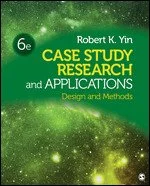Case Study Methods and Examples
By Janet Salmons, PhD Manager, Sage Research Methods Community
What is Case Study Methodology?
Case studies in research are both unique and uniquely confusing. The term case study is confusing because the same term is used multiple ways. The term can refer to the methodology, that is, a system of frameworks used to design a study, or the methods used to conduct it. Or, case study can refer to a type of academic writing that typically delves into a problem, process, or situation.
Case study methodology can entail the study of one or more "cases," that could be described as instances, examples, or settings where the problem or phenomenon can be examined. The researcher is tasked with defining the parameters of the case, that is, what is included and excluded. This process is called bounding the case, or setting boundaries.
Case study can be combined with other methodologies, such as ethnography, grounded theory, or phenomenology. In such studies the research on the case uses another framework to further define the study and refine the approach.
Case study is also described as a method, given particular approaches used to collect and analyze data. Case study research is conducted by almost every social science discipline: business, education, sociology, psychology. Case study research, with its reliance on multiple sources, is also a natural choice for researchers interested in trans-, inter-, or cross-disciplinary studies.
The Encyclopedia of case study research provides an overview:
The purpose of case study research is twofold: (1) to provide descriptive information and (2) to suggest theoretical relevance. Rich description enables an in-depth or sharpened understanding of the case.
It is unique given one characteristic: case studies draw from more than one data source. Case studies are inherently multimodal or mixed methods because this they use either more than one form of data within a research paradigm, or more than one form of data from different paradigms.
A case study inquiry could include multiple types of data:
multiple forms of quantitative data sources, such as Big Data + a survey
multiple forms of qualitative data sources, such as interviews + observations + documents
multiple forms of quantitative and qualitative data sources, such as surveys + interviews
Case study methodology can be used to achieve different research purposes.
Robert Yin, methodologist most associated with case study research, differentiates between descriptive, exploratory and explanatory case studies:
Descriptive: A case study whose purpose is to describe a phenomenon.
Explanatory: A case study whose purpose is to explain how or why some condition came to be, or why some sequence of events occurred or did not occur.
Exploratory: A case study whose purpose is to identify the research questions or procedures to be used in a subsequent study.
You can read the preface and Chapter 1 of Yin's book here. See the open-access articles below for some published examples of qualitative, quantitative, and mixed methods case study research.
References
Mills, A. J., Durepos, G., & Wiebe, E. (2010). Encyclopedia of case study research (Vols. 1-0). Thousand Oaks, CA: SAGE Publications, Inc. doi: 10.4135/9781412957397
Yin, R. K. (2018). Case study research and applications (6th ed.). Thousand Oaks: SAGE Publications.
Open-Access Articles Using Case Study Methodology
As you can see from this collection, case study methods are used in qualitative, quantitative and mixed methods research.
Ang, C.-S., Lee, K.-F., & Dipolog-Ubanan, G. F. (2019). Determinants of First-Year Student Identity and Satisfaction in Higher Education: A Quantitative Case Study. SAGE Open. https://doi.org/10.1177/2158244019846689
Abstract. First-year undergraduates’ expectations and experience of university and student engagement variables were investigated to determine how these perceptions influence their student identity and overall course satisfaction. Data collected from 554 first-year undergraduates at a large private university were analyzed. Participants were given the adapted version of the Melbourne Centre for the Study of Higher Education Survey to self-report their learning experience and engagement in the university community. The results showed that, in general, the students’ reasons of pursuing tertiary education were to open the door to career opportunities and skill development. Moreover, students’ views on their learning and university engagement were at the moderate level. In relation to student identity and overall student satisfaction, it is encouraging to state that their perceptions of studentship and course satisfaction were rather positive. After controlling for demographics, student engagement appeared to explain more variance in student identity, whereas students’ expectations and experience explained greater variance in students’ overall course satisfaction. Implications for practice, limitations, and recommendation of this study are addressed.
Baker, A. J. (2017). Algorithms to Assess Music Cities: Case Study—Melbourne as a Music Capital. SAGE Open. https://doi.org/10.1177/2158244017691801
Abstract. The global Mastering of a Music City report in 2015 notes that the concept of music cities has penetrated the global political vernacular because it delivers “significant economic, employment, cultural and social benefits.” This article highlights that no empirical study has combined all these values and offers a relevant and comprehensive definition of a music city. Drawing on industry research,1 the article assesses how mathematical flowcharts, such as Algorithm A (Economics), Algorithm B (Four T’s creative index), and Algorithm C (Heritage), have contributed to the definition of a music city. Taking Melbourne as a case study, it illustrates how Algorithms A and B are used as disputed evidence about whether the city is touted as Australia’s music capital. The article connects the three algorithms to an academic framework from musicology, urban studies, cultural economics, and sociology, and proposes a benchmark Algorithm D (Music Cities definition), which offers a more holistic assessment of music activity in any urban context. The article concludes by arguing that Algorithm D offers a much-needed definition of what comprises a music city because it builds on the popular political economy focus and includes the social importance of space and cultural practices.
Brown, K., & Mondon, A. (2020). Populism, the media, and the mainstreaming of the far right: The Guardian’s coverage of populism as a case study. Politics. https://doi.org/10.1177/0263395720955036
Abstract. Populism seems to define our current political age. The term is splashed across the headlines, brandished in political speeches and commentaries, and applied extensively in numerous academic publications and conferences. This pervasive usage, or populist hype, has serious implications for our understanding of the meaning of populism itself and for our interpretation of the phenomena to which it is applied. In particular, we argue that its common conflation with far-right politics, as well as its breadth of application to other phenomena, has contributed to the mainstreaming of the far right in three main ways: (1) agenda-setting power and deflection, (2) euphemisation and trivialisation, and (3) amplification. Through a mixed-methods approach to discourse analysis, this article uses The Guardian newspaper as a case study to explore the development of the populist hype and the detrimental effects of the logics that it has pushed in public discourse.
Droy, L. T., Goodwin, J., & O’Connor, H. (2020). Methodological Uncertainty and Multi-Strategy Analysis: Case Study of the Long-Term Effects of Government Sponsored Youth Training on Occupational Mobility. Bulletin of Sociological Methodology/Bulletin de Méthodologie Sociologique, 147–148(1–2), 200–230. https://doi.org/10.1177/0759106320939893
Abstract. Sociological practitioners often face considerable methodological uncertainty when undertaking a quantitative analysis. This methodological uncertainty encompasses both data construction (e.g. defining variables) and analysis (e.g. selecting and specifying a modelling procedure). Methodological uncertainty can lead to results that are fragile and arbitrary. Yet, many practitioners may be unaware of the potential scale of methodological uncertainty in quantitative analysis, and the recent emergence of techniques for addressing it. Recent proposals for ‘multi-strategy’ approaches seek to identify and manage methodological uncertainty in quantitative analysis. We present a case-study of a multi-strategy analysis, applied to the problem of estimating the long-term impact of 1980s UK government-sponsored youth training. We use this case study to further highlight the problem of cumulative methodological fragilities in applied quantitative sociology and to discuss and help develop multi-strategy analysis as a tool to address them.
Ebneyamini, S., & Sadeghi Moghadam, M. R. (2018). Toward Developing a Framework for Conducting Case Study Research. International Journal of Qualitative Methods. https://doi.org/10.1177/1609406918817954
Abstract. This article reviews the use of case study research for both practical and theoretical issues especially in management field with the emphasis on management of technology and innovation. Many researchers commented on the methodological issues of the case study research from their point of view thus, presenting a comprehensive framework was missing. We try representing a general framework with methodological and analytical perspective to design, develop, and conduct case study research. To test the coverage of our framework, we have analyzed articles in three major journals related to the management of technology and innovation to approve our framework. This study represents a general structure to guide, design, and fulfill a case study research with levels and steps necessary for researchers to use in their research.
Lai, D., & Roccu, R. (2019). Case study research and critical IR: the case for the extended case methodology. International Relations, 33(1), 67-87. https://doi.org/10.1177/0047117818818243
Abstract. Discussions on case study methodology in International Relations (IR) have historically been dominated by positivist and neopositivist approaches. However, these are problematic for critical IR research, pointing to the need for a non-positivist case study methodology. To address this issue, this article introduces and adapts the extended case methodology as a critical, reflexivist approach to case study research, whereby the case is constructed through a dynamic interaction with theory, rather than selected, and knowledge is produced through extensions rather than generalisation. Insofar as it seeks to study the world in complex and non-linear terms, take context and positionality seriously, and generate explicitly political and emancipatory knowledge, the extended case methodology is consistent with the ontological and epistemological commitments of several critical IR approaches. Its potential is illustrated in the final part of the article with reference to researching the socioeconomic dimension of transitional justice in Bosnia and Herzegovina.
Lynch, R., Young, J. C., Boakye-Achampong, S., Jowaisas, C., Sam, J., & Norlander, B. (2020). Benefits of crowdsourcing for libraries: A case study from Africa. IFLA Journal. https://doi.org/10.1177/0340035220944940
Abstract. Many libraries in the Global South do not collect comprehensive data about themselves, which creates challenges in terms of local and international visibility. Crowdsourcing is an effective tool that engages the public to collect missing data, and it has proven to be particularly valuable in countries where governments collect little public data. Whereas crowdsourcing is often used within fields that have high levels of development funding, such as health, the authors believe that this approach would have many benefits for the library field as well. They present qualitative and quantitative evidence from 23 African countries involved in a crowdsourcing project to map libraries. The authors find benefits in terms of increased connections between stakeholders, capacity-building, and increased local visibility. These findings demonstrate the potential of crowdsourced approaches for tasks such as mapping to benefit libraries and similarly positioned institutions in the Global South in multifaceted ways.
Mason, W., Morris, K., Webb, C., Daniels, B., Featherstone, B., Bywaters, P., Mirza, N., Hooper, J., Brady, G., Bunting, L., & Scourfield, J. (2020). Toward Full Integration of Quantitative and Qualitative Methods in Case Study Research: Insights From Investigating Child Welfare Inequalities. Journal of Mixed Methods Research, 14(2), 164-183. https://doi.org/10.1177/1558689819857972
Abstract. Delineation of the full integration of quantitative and qualitative methods throughout all stages of multisite mixed methods case study projects remains a gap in the methodological literature. This article offers advances to the field of mixed methods by detailing the application and integration of mixed methods throughout all stages of one such project; a study of child welfare inequalities. By offering a critical discussion of site selection and the management of confirmatory, expansionary and discordant data, this article contributes to the limited body of mixed methods exemplars specific to this field. We propose that our mixed methods approach provided distinctive insights into a complex social problem, offering expanded understandings of the relationship between poverty, child abuse, and neglect.
Rashid, Y., Rashid, A., Warraich, M. A., Sabir, S. S., & Waseem, A. (2019). Case Study Method: A Step-by-Step Guide for Business Researchers. International Journal of Qualitative Methods. https://doi.org/10.1177/1609406919862424
Abstract. Qualitative case study methodology enables researchers to conduct an in-depth exploration of intricate phenomena within some specific context. By keeping in mind research students, this article presents a systematic step-by-step guide to conduct a case study in the business discipline. Research students belonging to said discipline face issues in terms of clarity, selection, and operationalization of qualitative case study while doing their final dissertation. These issues often lead to confusion, wastage of valuable time, and wrong decisions that affect the overall outcome of the research. This article presents a checklist comprised of four phases, that is, foundation phase, prefield phase, field phase, and reporting phase. The objective of this article is to provide novice researchers with practical application of this checklist by linking all its four phases with the authors’ experiences and learning from recently conducted in-depth multiple case studies in the organizations of New Zealand. Rather than discussing case study in general, a targeted step-by-step plan with real-time research examples to conduct a case study is given.
VanWynsberghe, R., & Khan, S. (2007). Redefining Case Study. International Journal of Qualitative Methods, 80–94. https://doi.org/10.1177/160940690700600208
Abstract. In this paper the authors propose a more precise and encompassing definition of case study than is usually found. They support their definition by clarifying that case study is neither a method nor a methodology nor a research design as suggested by others. They use a case study prototype of their own design to propose common properties of case study and demonstrate how these properties support their definition. Next, they present several living myths about case study and refute them in relation to their definition. Finally, they discuss the interplay between the terms case study and unit of analysis to further delineate their definition of case study. The target audiences for this paper include case study researchers, research design and methods instructors, and graduate students interested in case study research.









How do you decide which methodology fits your study? In this dialogue Linda Bloomberg and Janet Boberg explain the importance of a strategic approach to qualitative research design that stresses alignment with the purpose of the study.